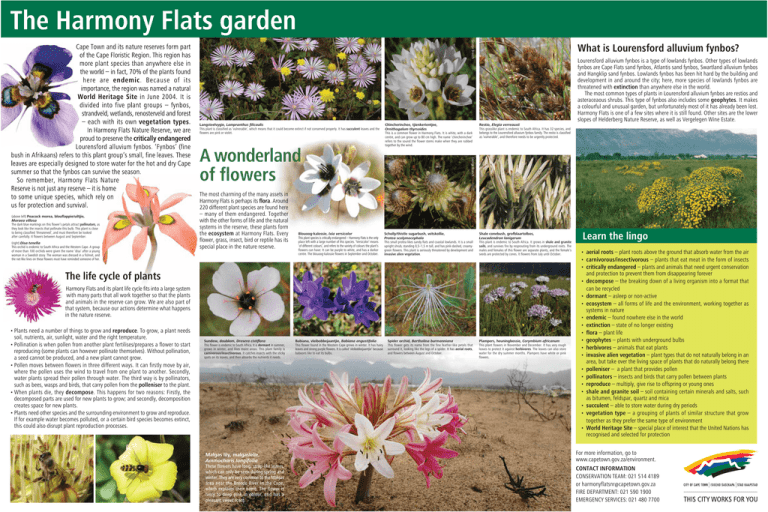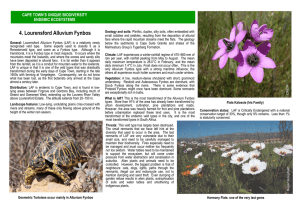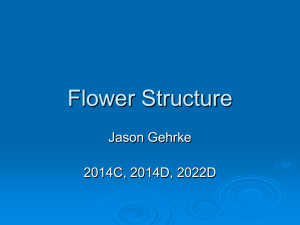What is Lourensford alluvium fynbos?
advertisement

The Harmony Flats garden George Branch Langsteelvygie, Lampranthus filicaulis This plant is classified as ‘vulnerable’, which means that it could become extinct if not conserved properly. It has succulent leaves and the flowers are pink or violet. (right) Disa tenella This orchid is endemic to South Africa and the Western Cape. A group of more than 100 orchids were given the name ‘disa’ after a young woman in a Swedish story. The woman was dressed in a fishnet, and the net-like lines on these flowers must have reminded someone of her. Blouoog-kalossie, Ixia versicolor This plant species is critically endangered – Harmony Flats is the only place left with a large number of this species. ‘Versicolor’ means ‘of different colours’, and refers to the variety of colours the plant’s flowers can have: It can be purple to white, and has a darker centre. The blouoog-kalossie flowers in September and October. Scholly/thistle sugarbush, witskollie, Protea scolymocephala This small protea likes sandy flats and coastal lowlands. It is a small upright shrub, standing 0,5–1,5 m tall, and has pink-dashed, creamygreen flowers. This plant is seriously threatened by development and invasive alien vegetation. Lourensford alluvium fynbos is a type of lowlands fynbos. Other types of lowlands fynbos are Cape Flats sand fynbos, Atlantis sand fynbos, Swartland alluvium fynbos and Hangklip sand fynbos. Lowlands fynbos has been hit hard by the building and development in and around the city; here, more species of lowlands fynbos are threatened with extinction than anywhere else in the world. The most common types of plants in Lourensford alluvium fynbos are restios and asteraceaous shrubs. This type of fynbos also includes some geophytes. It makes a colourful and unusual garden, but unfortunately most of it has already been lost. Harmony Flats is one of a few sites where it is still found. Other sites are the lower slopes of Helderberg Nature Reserve, as well as Vergelegen Wine Estate. Restio, Elegia verreauxii This grasslike plant is endemic to South Africa. It has 32 species, and belongs to the Lourensford alluvium fynbos family. The restio is classified as ‘vulnerable’, and therefore needs to be urgently protected. Rupert Koopman (above left) Peacock morea, blouflappie/uiltjie, Moraea villosa The dark blue markings on this flower’s petals attract pollinators, as they look like the insects that pollinate this bulb. This plant is close to being classified ‘threatened’, and must therefore be looked after carefully. It flowers between August and September. The most charming of the many assets in Harmony Flats is perhaps its flora. Around 220 different plant species are found here – many of them endangered. Together with the other forms of life and the natural systems in the reserve, these plants form the ecosystem at Harmony Flats. Every flower, grass, insect, bird or reptile has its special place in the nature reserve. George Branch A wonderland of flowers Chincherinchee, tjienkerientjee, Ornithogalum thyrsoides This is a common flower in Harmony Flats. It is white, with a dark centre, and can grow up to 80 cm high. The name ‘chincherinchee’ refers to the sound the flower stems make when they are rubbed together by the wind. What is Lourensford alluvium fynbos? Shale conebush, grofblaartolbos, Leucadendron lanigerum This plant is endemic to South Africa. It grows in shale and granite soils, and survives fire by resprouting from its underground roots. The males and females of this flower are separate plants, and the female’s seeds are protected by cones. It flowers from July until October. The life cycle of plants Harmony Flats and its plant life cycle fits into a large system with many parts that all work together so that the plants and animals in the reserve can grow. We are also part of that system, because our actions determine what happens in the nature reserve. • Plants need a number of things to grow and reproduce. To grow, a plant needs soil, nutrients, air, sunlight, water and the right temperature. • Pollination is when pollen from another plant fertilises/prepares a flower to start reproducing (some plants can however pollinate themselves). Without pollination, a seed cannot be produced, and a new plant cannot grow. • Pollen moves between flowers in three different ways. It can firstly move by air, where the pollen uses the wind to travel from one plant to another. Secondly, water plants spread their pollen through water. The third way is by pollinators, such as bees, wasps and birds, that carry pollen from the polleniser to the plant. • When plants die, they decompose. This happens for two reasons: Firstly, the decomposed parts are used for new plants to grow; and secondly, decomposition creates space for new plants. • Plants need other species and the surrounding environment to grow and reproduce. If for example water becomes polluted, or a certain bird species becomes extinct, this could also disrupt plant reproduction processes. Sundew, doublom, Drosera cistiflora This flower is endemic to South Africa. It is dormant in summer, grows in winter, and likes moist areas. This plant family is carnivorous/insectivorous. It catches insects with the sticky spots on its leaves, and then absorbs the nutrients it needs. Malgas lily, malgaslelie, Ammocharis longifolia These flowers have long, strap-like leaves, which can only be seen during spring and winter. They are very common to the Malgas area near the Breede River in the Cape, which explains their name. The flower is ivory to deep pink in colour, and has a pleasant sweet scent. Babiana, vleibobbejaantjie, Babiana angustifolia This flower found in the Western Cape grows in winter. It has hairy leaves and strong purple flowers. It is called ‘vleibobbejaantjie’ because baboons like to eat its bulbs. Spider orchid, Bartholina burmanniana This flower gets its name from the fine feather-like petals that surround it, looking like the legs of a spider. It has aerial roots, and flowers between August and October. Plampers, heuningbossie, Corymbium africanum This plant flowers in November and December. It has very rough leaves to protect it against herbivores. The leaves can also store water for the dry summer months. Plampers have white or pink flowers. Learn the lingo • aerial roots – plant roots above the ground that absorb water from the air • carnivorous/insectivorous – plants that eat meat in the form of insects • critically endangered – plants and animals that need urgent conservation and protection to prevent them from disappearing forever • decompose – the breaking down of a living organism into a format that can be recycled • dormant – asleep or non-active • ecosystem – all forms of life and the environment, working together as systems in nature • endemic – found nowhere else in the world • extinction – state of no longer existing • flora – plant life • geophytes – plants with underground bulbs • herbivores – animals that eat plants • invasive alien vegetation – plant types that do not naturally belong in an area, but take over the living space of plants that do naturally belong there • polleniser – a plant that provides pollen • pollinators – insects and birds that carry pollen between plants • reproduce – multiply, give rise to offspring or young ones • shale and granite soil – soil containing certain minerals and salts, such as bitumen, feldspar, quartz and mica • succulent – able to store water during dry periods • vegetation type – a grouping of plants of similar structure that grow together as they prefer the same type of environment • World Heritage Site – special place of interest that the United Nations has recognised and selected for protection For more information, go to www.capetown.gov.za/environment. CONTACT INFORMATION CONSERVATION TEAM: 021 514 4189 or harmonyflatsnr@capetown.gov.za FIRE DEPARTMENT: 021 590 1900 EMERGENCY SERVICES: 021 480 7700





